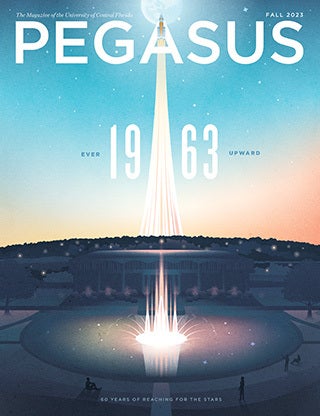While Marvel fans have waited a year to see how Endgame would resolve certain “endings” in Infinity Wars, the scientific possibilities presented in the film are equally worthy of anticipation. From the real capabilities of nanotechnology to determining if quantum reality is actually a thing, we asked two researchers at UCF’s NanoScience Technology Center to provide their expertise on some of the movie’s scientific elements.
Here physics Professor Saiful Khondaker and material science and engineering Professor Swaminathan Rajaraman share their thoughts on the science mentioned in the film:
Is the nanotechnology as real as it is portrayed in the film’s suits for Iron Man, Spider-Man’s Iron Spider and Ant-Man?
Saiful Khondaker: Some people have shown carbon nanotube fibers can be used to create strong fabric, which may be used to create suits for soldiers. While nanotech may be used for creating materials with higher mechanical strengths and can in principle create super strong suits, the suit made of nanotech used in the movie is a fantasy at this time.
Swaminathan Rajaraman: I’m fascinated with the materials and the sensors involved in such fictional suits. For instance, Iron Man’s suit is composed in one of the instances from “neurokinetic user-controlled nanoparticle bundles.” While such considerations are wildly imaginative and not true it does provide interesting research ideas. Can one create such nanoparticles or arc reactors that power Iron Man’s suit to attain some impossible goals?
The suits in their current appearance are vastly exaggerated for sure but do provide ideas for what scientists and engineers can work on in the future development of smart materials, self-powering, biological power and smart clothing.
In the 2015 film Ant Man, the quantum realm, which Hank Pym describes as “a reality where all concepts of time and space become irrelevant as you shrink for all eternity,” is mentioned in the MCU for the first time. This concept is explored again in Endgame. Is the quantum realm real?
SK: While subatomic particles are real, and while the space and time concept mentioned in the movie is also real for these particles, I think the phrase “quantum realm” is fictional. They are using a lot of scientific words, connecting them together as technical jargon, in a fictional way.
How do nanotechnology and quantum concepts intersect in the movie and real life?
SK: Nanotechnology and the quantum realm do not intersect as mentioned in the movie. As the movie mentions, nanotechnology does use a lot of quantum physics concepts and many properties of nanosystems are derived from quantum physics in real life. Although quantum laws do govern both nanoparticles and subatomic particles, which are mentioned in the quantum realm, these two are completely different.
SR: In real life, nanotechnology, especially sensors and nanomaterials, are all around us. We just don’t realize that most of the time we are interacting with nanoscale molecules or materials from the simple acts, such as sending a text message or measuring your heart rate with a wearable sensor, we are interacting with nanotechnology.
Can movies, even ones that are far-fetched, play a role in educating our society about science? If so, how and why?
SR: Absolutely if the lessons from the movies can be taken in the right spirit. I think the scientific education piece in movies, even through far-fetched theories, is very important as they drive discussions and scientific thought into these subjects. The curiosity they can impart to young minds is endless and even if a small portion of these young minds follow through with reading and writing about these topics it can be very beneficial to our future.
SK: The answer is yes (in my opinion). It introduces the audience to the new scientific terms, gets them excited, creates positive attitudes and often lets them explore the topics further.





